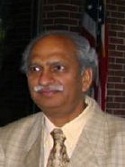| Biography | |
|---|---|
 Prof. Ravi P. Agarwal Texas A&M University, USA |
|
| Title: Existence and uniqueness results for a nonlinear integral equation related to infectious disease | |
| Abstract: In the paper [1] the nonlinear integral equation
was interpreted as a model for the spread of certain infectious diseases with periodic contact rate that varies seasonally. In (1), x(t) represents the proportion of infectives in the population at time t, f(t, x(t)) (which is periodic in t, i.e. there exists w > 0 with f(t + w, x) = f(t, x) for all t 2 R and x > 0) is the proportion of new infectives per unit time and > 0 is the length of time an individual remains infectious. Authors in [1] were interested in obtaining a nontrivial periodic nonnegative solution to (1). They used Krasnoselskii’s fixed point theorem in a cone to achieve this. Over the period of last 46 years several extensions of (1) have been studied in which the existence of positive solutions, periodic solutions, pseudo-almost- periodic solution, etc. have been examined. In this lecture we shall consider the integral equation
to provide sufficient conditions for the existence and uniqueness of positive solutions. We shall also provide an iterative algorithm that converges to the unique solution. Our obtained results are supported by two examples. For this we shall apply a fixed point theorem proved in [2] for the convex- concave and nondecreasing operators defined in a Banach space with a normal solid cone. Our talk is based on a recently published paper [3].
[1]. K.L. Cooke and J.L. Kaplan, A periodicity threshold theorem for epi- demics and population growth, Mat. Biosci. 31 (1976) 87-104 [2]. D. Guo, Y.J. Cho, J. Zhu, Partial Ordering Methods in Nonlinear Problems, Nova Science, New York (2004). [3]. R.P. Agarwal, M. Jleli and B. Samet, An investigation of an integral e- quation involving convex-concave nonlinearities, Mathematics, 2021(2021), pp. 10, 9, 2372, https://doi.org/10.3390/math9192372 | |


